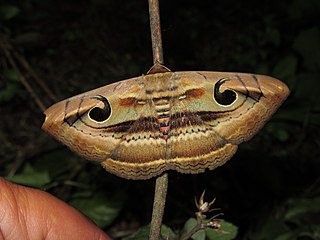
Mocis undata, the brown-striped semilooper, is a moth of the family Erebidae. The species was first described by Johan Christian Fabricius in 1775. It is found in the Afrotropical and Oriental regions, including India and Sri Lanka.

Mythimna albipuncta, the white-point, is a moth of the family Noctuidae. The species was first described by Michael Denis and Ignaz Schiffermüller in 1775. It is distributed throughout Europe and one subspecies is found in Tunisia. It is also found in Asia Minor, Armenia, and Iran, and the northeastern United States.

Pachetra is a monotypic moth genus of the family Noctuidae erected by Achille Guenée in 1841. Its only species, Pachetra sagittigera, the feathered ear, was first described by Johann Siegfried Hufnagel in 1766. It is found in central and southern Europe, east to the Ural, north to southern England, Sweden and Finland. Southwards it is found from Anatolia, central Asia and the Altai up to Mongolia. It is also present in North Africa.

Periphanes is a monotypic moth genus of the family Noctuidae first described by Jacob Hübner in 1821. Its only species, Periphanes delphinii, the pease blossom, was first described by Carl Linnaeus in his 1758 10th edition of Systema Naturae. It can be found from Afghanistan and the steppe areas of Central Asia and Anatolia up to the area surrounding the Mediterranean Sea and north-western Africa.

Spirama is a genus of moths in the family Erebidae first described by Achille Guenée in 1852.

Hulodes caranea is a species of moth of the family Erebidae first described by Pieter Cramer in 1780. It is found from India, Sri Lanka, Myanmar, Java, Hong Kong to Queensland and New Guinea, it is also found on the Marianas and Carolines.

Mesapamea secalis, the common rustic, is a moth of the family Noctuidae. The species was first described by Carl Linnaeus in his 1758 10th edition of Systema Naturae. It is found in Europe, north-west Africa, Turkey and northern Iran.

Mythimna decisissima is a moth of the family Noctuidae first described by Francis Walker in 1856. It is found from India across south-east Asia including Hong Kong, Japan, Taiwan and Australia in Queensland and New South Wales. It is also present in South Africa.

Spirama helicina is a moth of the family Erebidae first described by Jacob Hübner in 1824. In older texts, the species was classified as morph of Spirama retorta.

Phyllodes consobrina is a noctuoid moth in the family Erebidae and subfamily Calpinae. It was first described by John O. Westwood in 1848. The species can be found in Asia, including Thailand, Sri Lanka, Bangladesh, the Andamans and India.

Eucyclodes gavissima, the Oriental orange banded green geometer moth, is a species of moth of the family Geometridae described by Francis Walker in 1861. It is found in the Indian subregion, Sri Lanka, Bhutan, western China, Taiwan, Vietnam, Sumatra and Borneo.

Serrodes campana is a species of moth of the family Erebidae first described by Achille Guenée in 1852. It is found from the Indo-Australian tropics to eastern Australia, Fiji, Samoa and New Caledonia. It is also present in Japan, Korea and Sri Lanka. The adult is a fruit piercer, but also feeds on flower nectar.

Ischyja manlia is a species of moth of the family Noctuidae first described by Pieter Cramer in 1776. It is found in the Indian subregion, Sri Lanka, Myanmar, Thailand, China, Okinawa, Sundaland, Sulawesi, Korea, the southern Moluccas, Australia (Queensland) and Palau. Adults pierce the skin of fruit to suck the juice.

Blasticorhinus rivulosa is a moth of the family Noctuidae. It is found in Japan, Taiwan, India and Sri Lanka.

Gesonia obeditalis is a species of moth of the family Noctuidae first described by Francis Walker in 1859. It is found from eastern Africa, the Seychelles, the Maldives and the Oriental tropics of India, Myanmar, Sri Lanka east to the Philippines, the Sula Islands and Australia. The adult moth has brown wings with a scalloped dark brown band near the margin. The hindwings are similar in pattern to the forewings but are a paler shade of brown.

Maliattha signifera is a species of moth of the family Noctuidae first described by Francis Walker in 1858. It is found in south-east Asia, including China, India, Japan, Taiwan, Korea and Thailand as well as in Australia (Queensland).
Metacrateria pulverulella is a species of snout moth. It was described by George Hampson in 1918. It is found in Sri Lanka.

Spirama retorta, the Indian owlet-moth, is a moth of the family Erebidae. The species was first described by Carl Alexander Clerck in 1764. It is found in China, Korea, Japan (Honshu), India, Nepal, Bangladesh, Thailand, Cambodia, Myanmar, Vietnam, Taiwan, Sri Lanka, Malaysia, the Philippines (Luzon), Indonesia ,Japan.

Spilosoma melanopsis is a moth in the family Erebidae. It was described by Francis Walker in 1865. It is found in Sri Lanka.

Pantydia metaspila is a species of moth of the family Erebidae first described by Francis Walker in 1858. It is found in China, Japan (Ryukyus), India (Maharashtra), Thailand, Taiwan, the Maledives, Sri Lanka, the Philippines, Borneo, Sumatra, Sulawesi, the Tanimbar Islands, Seram, Papua New Guinea, the Caroline Islands, the Solomon Islands, Vanuatu, Fiji, as well as Australia, where it has been recorded from Queensland.



















